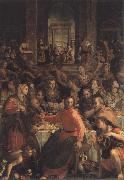Wholesale Oil Painting No Minimum |
|||||||||||
|
|
|||||||||||

|
|||||||||||
|
|
|
||||||||
ALLORI AlessandroItalian Mannerist Painter, 1535-1607 Born in Florence. After the death of his father in 1540 he was brought up and trained in art by a close friend, often referred to as his 'uncle', the mannerist painter Agnolo Bronzino, whose name he sometimes assumed in his pictures. In some ways, Allori is the last of the line of prominent Florentine painters, of generally undiluted Tuscan artistic heritage: Andrea del Sarto worked with Fra Bartolomeo (as well as Leonardo Da Vinci), Pontormo briefly worked under Andrea, and trained Bronzino, who trained Allori. Subsequent generations in the city would be strongly influenced by the tide of Baroque styles pre-eminent in other parts of Italy. Freedburg derides Allori as derivative, claiming he illustrates "the ideal of Maniera by which art (and style) are generated out of pre-existing art." The polish of figures has an unnatural marble-like form as if he aimed for cold statuary. It can be said of late phase mannerist painting in Florence, that the city that had early breathed life into statuary with the works of masters like Donatello and Michelangelo, was still so awed by them that it petrified the poses of figures in painting. While by 1600 the Baroque elsewhere was beginning to give life to painted figures, Florence was painting two-dimensional statues. Furthermore, in general, with the exception of the Contra Maniera artists, it dared not stray from high themes or stray into high emotion. |
||||||||
|
|
||||||||
The wedding to canons
The wedding to canons Painting ID:: 45485 |
mk186
1592 Florence church Sant' Agata mk186 1592 Florence church Sant' Agata |
|||||||
|
|
||||||||
Paolo Veronese1528-1588 Paolo Veronese Galleries Italian painter and draughtsman. With Titian and Tintoretto he makes up the triumvirate of great painters of the late Renaissance in Venice. He is known as a supreme colourist and for his illusionistic decorations in both fresco and oil. His large paintings of biblical feasts executed for the refectories of monasteries in Venice and Verona are especially celebrated. He also produced many altarpieces, history and mythological paintings and portraits. His compositional sketches in pen, ink and wash, figure studies in chalk, and chiaroscuro modelli and ricordi form a significant body of drawings. He headed a family workshop that remained active after his death. |
||||||||
|
|
||||||||
|
|
The wedding to canons
The wedding to canons Painting ID:: 45692 |
mk186
1552/63 Paris muse you Louvre mk186 1552/63 Paris muse you Louvre |
||||||
|
|
||||||||
Paolo Veronese1528-1588 Paolo Veronese Galleries Italian painter and draughtsman. With Titian and Tintoretto he makes up the triumvirate of great painters of the late Renaissance in Venice. He is known as a supreme colourist and for his illusionistic decorations in both fresco and oil. His large paintings of biblical feasts executed for the refectories of monasteries in Venice and Verona are especially celebrated. He also produced many altarpieces, history and mythological paintings and portraits. His compositional sketches in pen, ink and wash, figure studies in chalk, and chiaroscuro modelli and ricordi form a significant body of drawings. He headed a family workshop that remained active after his death. |
||||||||
|
|
||||||||
|
|
The wedding to canons
The wedding to canons Painting ID:: 45710 |
mk186
1552-63 Paris muse you Louvre mk186 1552-63 Paris muse you Louvre |
||||||
|
|
||||||||
|
Paolo Veronese 1528-1588 Paolo Veronese Galleries Italian painter and draughtsman. With Titian and Tintoretto he makes up the triumvirate of great painters of the late Renaissance in Venice. He is known as a supreme colourist and for his illusionistic decorations in both fresco and oil. His large paintings of biblical feasts executed for the refectories of monasteries in Venice and Verona are especially celebrated. He also produced many altarpieces, history and mythological paintings and portraits. His compositional sketches in pen, ink and wash, figure studies in chalk, and chiaroscuro modelli and ricordi form a significant body of drawings. He headed a family workshop that remained active after his death. The wedding to canons mk186 1552-63 Paris muse you Louvre |
||||||||
|
|
||||||||
|
Prev Next
|
||||||||
|
|
||||||||
|
Related Paintings to Paolo Veronese :. |
||||||||
|
|
||||||||
|
CONTACT US |



